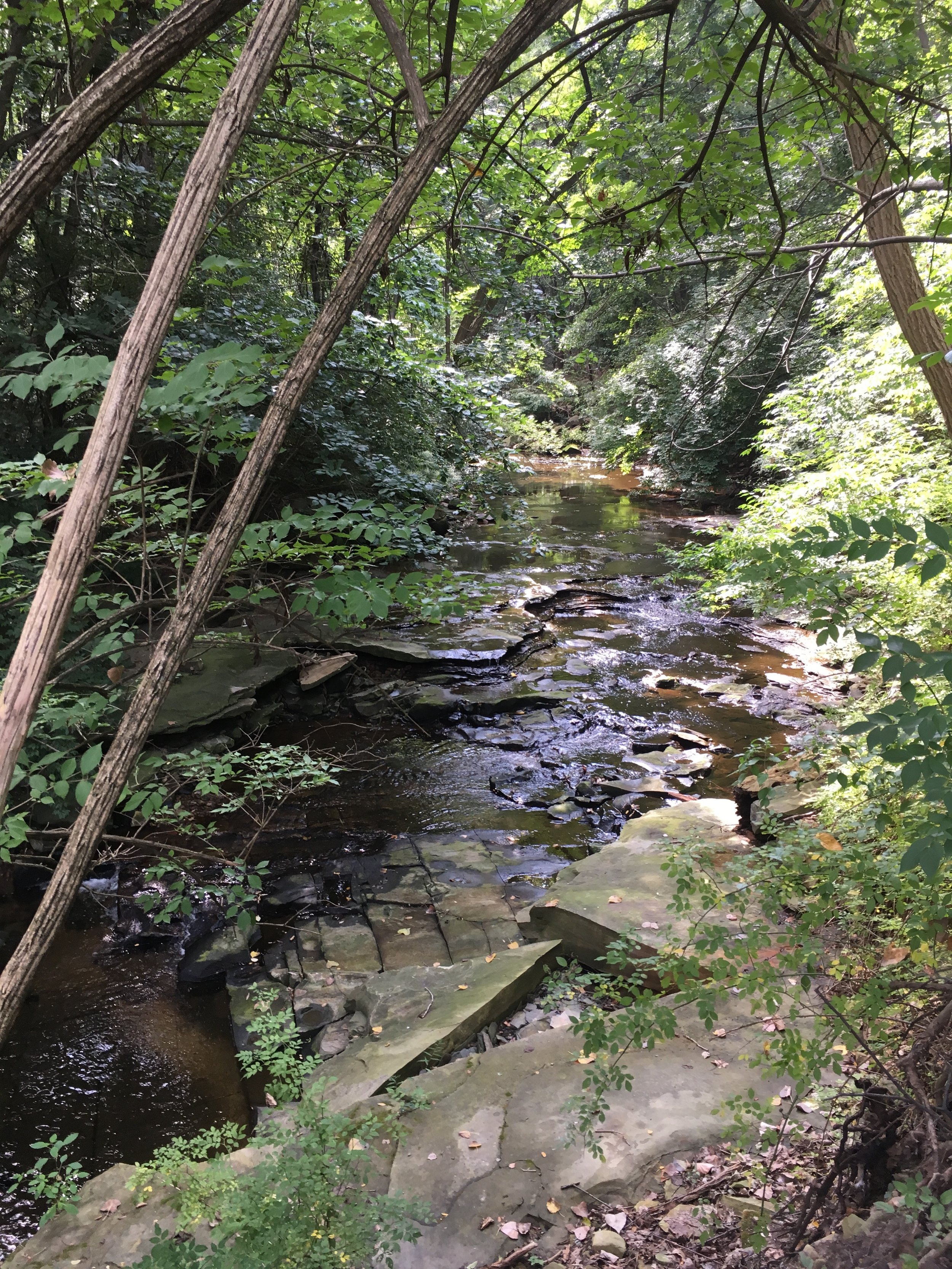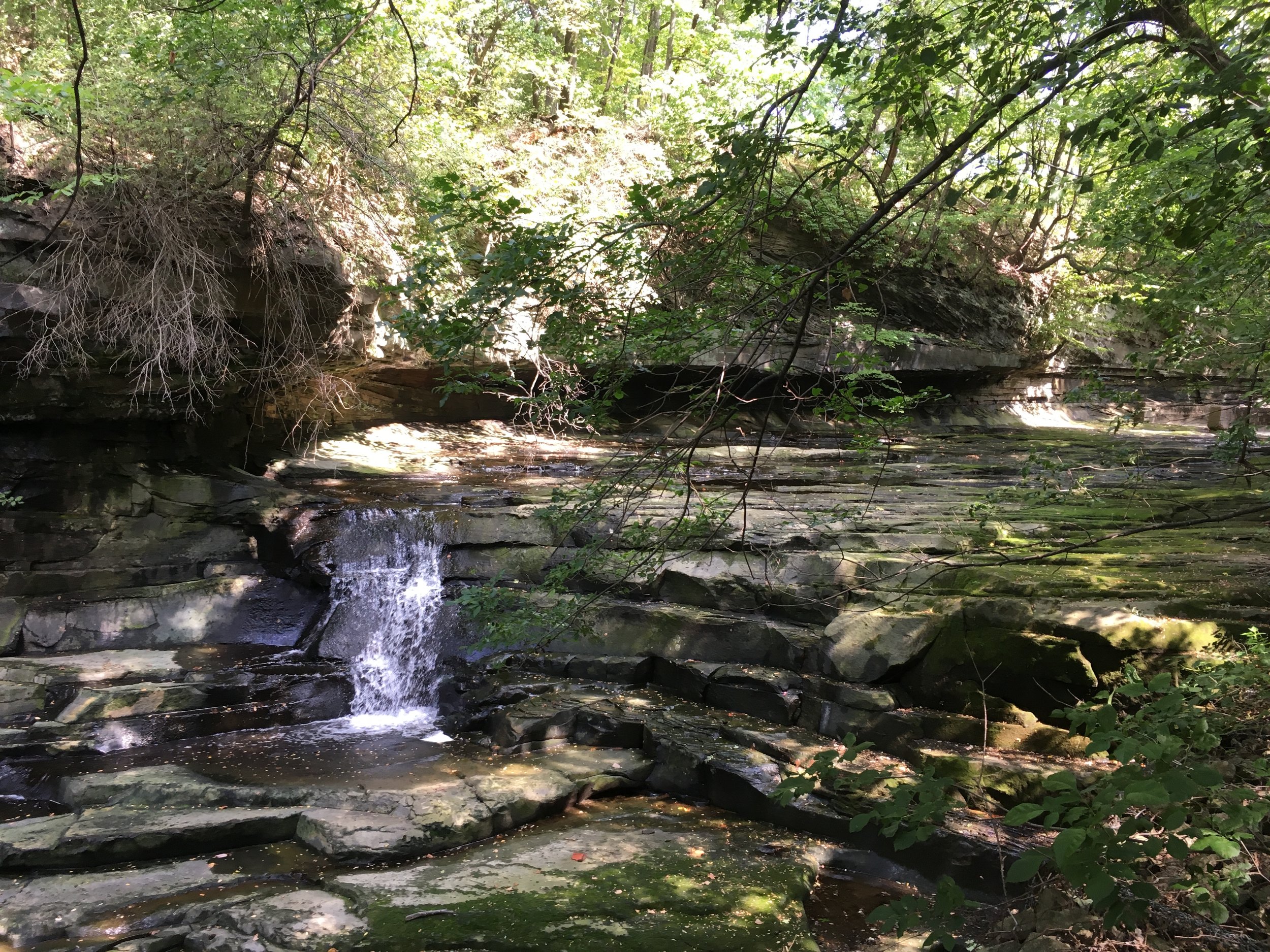At Watershed, we always planned to do an episode about Doan Brook. After all, it’s the reason our show has the title it does, because it ties together all the neighborhoods we cover - Buckeye, Mount Pleasant and Woodland Hills.
Without further ado, here it is!
Hidden in plain sight
A few years ago, I used to live right next to the brook. But I didn’t even know it was there. As I’d drive up busy Fairhill Road to my apartment, I was always aware there was “something,” back there, in the woods at the side of the road. But I didn’t know what.
That’s a lot of people’s relationship with Doan Brook. They don’t know about it, and if they do, they don’t pay much attention. Big deal. A stream.
Then, years after I moved away, I heard there was this really beautiful trail right, through a gorge full of boulders and deer and a waterfall. Basically, I had a secret Narnia right in my backyard, and I never knew it.
So I called up Tori Mills and asked her to show me around. Tori is the director of the Doan Brook Watership Partnership, and all about getting people to care more about this little stream.
"Down in the gorge is extremely quiet and peaceful, an urban oasis," she tells me.
Oh and by the way? There's a waterfall. Who knew?
We’re also joined by Katie Kirtley, a retired post office worker who just got hired to do some public outreach for the Partnership.
Katie lives in the neighborhood, off Buckeye Road, and like me, she’s never been on this hike.
You can tell right away we’re both city people. I’m wearing old hiking boots with laces that won’t stay tied. Katie’s stylishly dressed in a blue blouse, short pants, and scarf - to ward off mosquitoes.
"The most fashionable hiker in the watershed," Tori jokes.
"Yeah," Katie says. "Because otherwise I might get bit by mosquitoes."
On the road
As the three of us walk along Fairhill Road, Tori Mills tells us why it’s important that more people know about Doan Brook in general and the gorge hike in particular.
She says there’s a ton of research that being out in nature can reduce people’s risk of illness. Mental, physical, pretty much everything - from Alzheimer’s to diabetes to ADHD. All from just seeing leaves and squirrels and hearing birds chirping.
Just as an example, one study from Stanford University a couple years ago compared the brains of people who walked in nature with the brains of folks who walked along a busy highway. The researchers looked at the particular brain area associated with depression. In the hikers’ brains, that area lit up way less.
And those benefits may be especially important in the city neighborhoods around the Gorge - Buckeye, Mount Pleasant and Woodland Hills. Poverty rates are 50 percent or more, and a lot of people suffer from high blood pressure, diabetes and mental illness.
"Urban parks are critical to healthier neighborhoods," Tori tells us. "And so making sure this tremendous resource is realized by people around us is critical."
Then she says something that really hits me. In the 70 square miles or so between the Cuyahoga River downtown and Euclid Creek at the city's eastern edge, the Doan Brook corridor provides the only natural green space.
Only. As in, that's it.
When Cleveland was booming back in the early 1900s, nobody thought much about parks. It was all about cramming in as many houses in as little space as possible. Now, Doan Brook is the only place for miles around where us city dwellers can get a workout outside a gym or a busy road.
"In here," Tori says, "this is our chance to really get our heart pumping in a setting that is not a treadmill at the gym with CNN blaring above us, you know?"
There’s a secondary benefit to getting your daily stepcount in the great outdoors.
The more people see the stream, the more they’ll care about it. The more they care about it, the more they’ll want to keep it clean, and that is good not just for the Brook, but for the place where the Brook ends up.
Lake Erie. 18th largest freshwater lake in the world, source of drinking water for 11 million people. Home to one of the richest fish populations in the Great Lakes.
Suddenly, a stream!
And then all the sudden, under an overpass and through a field, there we are: the Brook.
It really is like entering another world. Just a few yards away from the road. Birds chirping. Late summer cicadas.
I ask Katie how she feels.
"Kinda quiet," she says. "Serene."
We walk deeper into the woods, along a trail. Up and then down.
Katie wants to know if there are any snakes.
"That’s a question we get a lot," Tori says, laughing. "That and bears!"
Strategically, though, she doesn't answer.
"I need a stick," Katie mumbles.
"To kill the snake?" I ask.
"No," she says. "Just to flick it somewhere."
And then the grand finale: The waterfall. A real one!
It cascades over some ledges and splashes down into a deep, clear pool.
"If people didn’t believe there was the gorge, they definitely didn't believe there was something as pretty as the waterfall," Tori says.
She says it's at its lowest point all year. Often, you don’t see any rock at all, just whitewater.
As we finish up our hike, we head up a side trail back to Fairhill Road.
"My cardio is on," Katie says with a laugh. "I’m breathing hard."
We emerge from the treeline, back out onto Fairhill, and the modern world. The woods all but vanish behind us.
"Yeah this is something," Katie says. "I didn’t even know this was back here."
I ask how many times she's driven by without noticing the brook or the gorge.
"Oh, thousands," she says. "Thousands. We used to go to the doctor’s office right there at Fairhill."
She pauses.
"Took me like, what, 40 years to find out what’s over here? How about that."
'We don't belong'
A few weeks after our hike, a guy named Dudley Edmondson comes to town. He’s a nature advocate from Duluth, Minnesota, and the author of Black and Brown Faces in America’s Wild Places.
He’s here to give a series of talks about diversifying public parks and nature equity — the idea that everybody — regardless of income level, race, ethnicity — needs access to natural places to feel healthy.
He says as a kid growing up with alcoholic parents, nature for him was a refuge. But being black, that wasn’t something that a lot of his peers understood, or accepted.
"They used to call me Euell Gibbons," he says.
"He was an old white guy on Grape Nuts commercials and he’d always say, 'Did you know many parts of this plant are edible?'
"The kids used to tease me and call me Euell Gibbons because I liked nature, collecting bees and praying mantises. And kids made fun of me because they either thought [those things] were nerdy or stupid things that white people did."
He says the idea that natural places like the Doan Brook gorge aren’t really for black people has deep roots.
"I think for people of color, people not in the dominant culture, I believe there’s probably some level of feeling that things don’t necessarily belong to them," he says. "So if there’s no one living on it, it’s probably owned by either a white person or the city officials but the most important thing is it’s not yours."
Dudley still grapples with that feeling in his own life, even though he’s someone who goes out into nature for a living.
"Even now as an adult I still do not really access land that I’m not 100% sure who the owner is," he says. "I will look for signage before I step onto land."
When he talks about that with white friends, they don't get it.
"They figure if they go on the land and the owner comes out they’ll just explain themselves and everything will go fine," he says. "And as a black man I think, ‘Well first you’ll see the shotgun and then you’ll hear the bullets flying and have to find a way out of that situation.’"
He says that perceived lack of access is the real origin of the old stereotype that black people just aren’t interested in hiking or the woods.
"If people don’t know something exists then maybe that also creates a lack of interest," he says.
When it comes to the Doan Brook gorge, the solution, he says, is just to make it really obvious that it’s a park. As in, open to everyone.
"You really need to put out a welcome mat," he says. "I’m not saying put out a sign, ‘Black people welcome.’ I’m saying, though, do it in a way where the message is communicated, they understand this is a public space and they’re more than welcome."
Having people of color on staff, maintaining and interpreting the park, can also encourage more diversity in vistorship.
Whatever is done, though, it shouldn't be about ‘getting black people to think nature is cool.’
It should be just about making sure everyone has the chance to discover how both stimulating and healing it can be to tramp through fallen leaves. With sun on your skin, and just the sound of birds and water in your ears.
Telling you that your problems - maybe they can be solved. That the world will go on.
That you belong.




